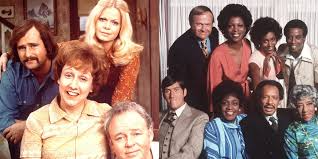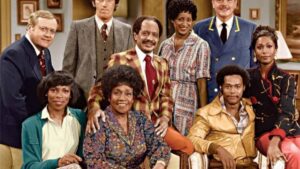
Marla Gibbs, one of the last surviving cast members of “The Jeffersons,” is 93 years old, but breezily insists during a recent phone interview that she’d actually prefer to be a little bit younger. “God said we are physical beings as well as spiritual beings,” she explains, “but as spiritual beings, we don’t have an age, so I choose to be 30.”
What, then, does this spry 30-year-old spiritual being who’s still a working actor (“Grey’s Anatomy,” “One Life to Live”) remember most about the sitcom that just turned 50 and made her into a household name during the 1970s and ’80s?
“We were like a family,” she recalls. “We were very happy. We were a very happy set.”
Sherman Hemsley was ‘morbidly shy’
George (Sherman Hemsley) and Louise (Isabel Sanford) in their deluxe…
George (Sherman Hemsley) and Louise (Isabel Sanford) in their deluxe apartment in the sky. Credit: Everett Collection
Gibbs says that Sherman Hemsley — George Jefferson, of course — was almost morbidly shy, so that whenever the cast had to venture out in public, the other cast members would shield him from autograph hounds or other assertive well-wishers. Isabel Sanford — Louise — was the rock of the show who was always prepared and always on-time. Gibbs’ best friend on the set was Roxie Roker, who was Mrs. Willis, the Jeffersons upstairs neighbor, married to Tom — Franklin Cover. (Roker, who died in 1995, is the mother of Lenny Kravitz.)
Gibbs herself played the Jeffersons’ maid, Florence Johnston. At the time a TV novice and mother of three, Gibbs had been working as a reservation agent for United Airlines and figured she’d have a walk-on then be gone. Instead, her TV prospects were about to brighten.

At the outset of the Jan. 18, 1975, pilot, Ja’Net DuBois’ indelible theme song told viewers that the Jeffersons from “All in the Family” had moved on up from Queens to a “deluxe apartment in the sky” (12th floor at 185 E. 85th St., to be exact). George’s dry cleaning business had turned into a lucrative mini-empire, and he was about to flaunt his wealth. In this first episode, Florence was astounded to learn that her new employer was actually Black and by the end landed the line that would become just about as memorable as that theme:
“How come we overcame and nobody told me?”
Gibbs: ‘The Jeffersons’ was a ‘whole new thing’
Florence (Marla Gibbs) meets Wally “Famous” Amos in the 1980…
Florence (Marla Gibbs) meets Wally “Famous” Amos in the 1980 episode “The Jeffersons Go to Hawaii.” Credit: CBS/Everett Collection
Gibbs remained on as a key cast member and indispensable foil to George whose bombast demanded a zetz from time to time which Florence cheerfully provided. She has since appeared in dozens of shows, landed her own spinoff, produced and starred in her own hit (“227”), and got five straight Emmy nominations for that long-ago role of a lifetime. (Only Sanford won an Emmy — a first for a Black leading actress in a comedy — in 1981.) The show changed her life and American culture, too. Ask her what all that means now, and just like Florence, Gibbs has the obvious answer.
“As a child growing up in Chicago, I loved the movies and mostly the musicals, but I didn’t see any Black people in them, and then came ‘The Jeffersons’ and it was a whole new thing! On the show we accepted it like we had always been there. I guess we had always wanted to be there anyway.” She adds, “It was a phenomenal moment for me.”
A sensation and shock to viewers
Sammy Davis Jr. guest-starred in a 1984 episode, “What Makes…
Sammy Davis Jr. guest-starred in a 1984 episode, “What Makes Sammy Run?” Credit: CBS/Everett Collection
You can still catch isolated seasons and episodes of “The Jeffersons,” scattered across free streaming services (Tubi, Pluto, YouTube) or a few broadcast channels like Antenna TV. There remain devoted fans who go to signings (Gibbs still attends them, too). Otherwise, it’s become a relic of ’70s pop culture, seemingly as dated as disco, or as bygone as bell-bottoms. But in the moment, it was a sensation and a shock to a TV nation only just then getting accustomed to Black faces, voices and lives in prime-time. “The Jeffersons” was hardly a pioneer — two other Norman Lear creations, “Good Times” (1974-79) and “Sanford and Son” (1972-77) came before — but it was a groundbreaker and rabble rouser. Like George, there was no holding back.
